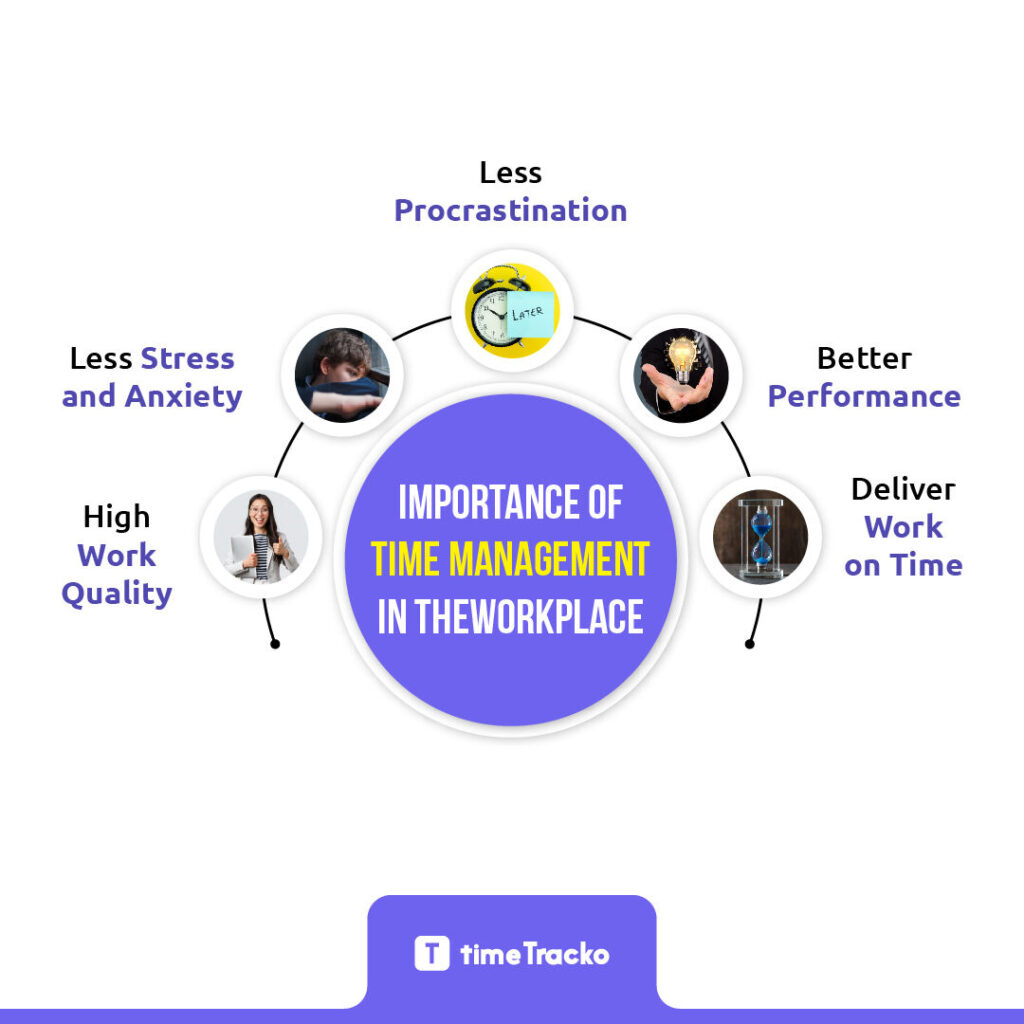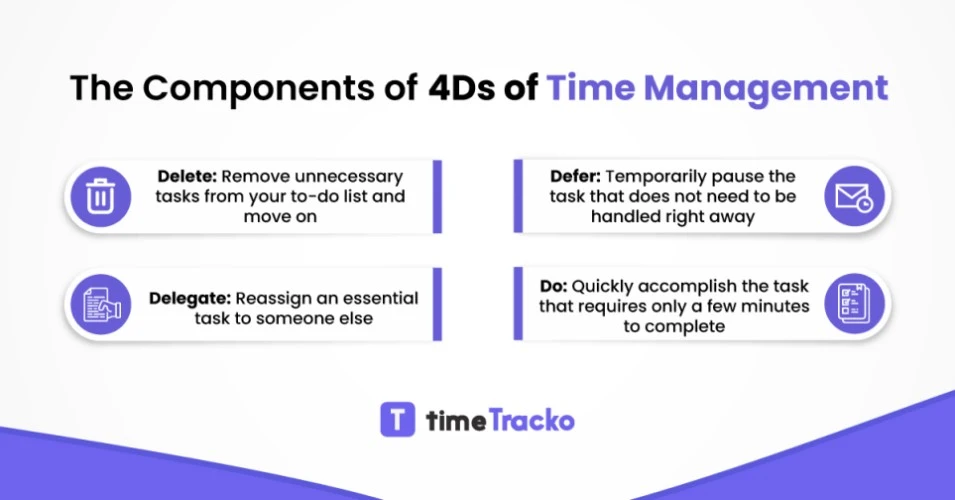Guide To 4 Ds of Time Management – When and How to use
Guide To 4 Ds of Time Management – When and How to use
Isn’t it frustrating when there doesn’t seem to be enough time in the day? But, there are also some people who manage their time better than others? If you wondering how is it possible then, the answer is “Good Time Management.”
As there is a saying that goes,
“Take care of the minutes, and the hours will take care of themselves.” – Lord Chesterfield
With your ever-growing to-do list, it’s a good time to look into time management techniques and optimize your schedule. There are several different methods and techniques you can use for optimizing your time, but 4Ds of time management is totally effective for you.
In this article, we will discuss the 4 Ds of time management, an easy method to manage your time, and your to-do lists. But, before we get started, let’s take a look at what time management actually means.
What is Time Management?
Time management is about organizing your time and planning to divide it between the different activities you have to do. In doing it right, you will work smarter instead of harder, accomplishing more in less time, especially when things get tough.

If you do not manage your time well, you may suffer in your work and well-being which may lead to you
- Getting behind on a deadline
- Increasing your stress level values
- Negatively impacting your professional reputation
- Creating low-quality work
Moreover, businesses and freelancers require strong time management and leadership skills to maximize the time they have available to grow their businesses. You can also find several different kinds of time management tools/software are available in the market such as:
- timeTracko – Best work time tracking software
- Evernote– One place for all your notes
- Focus Keeper– Boost motivation to complete tasks
- Dropbox– Store large files and share them with ease
However, understanding the 4Ds of time management is the most important step to beginning time management.
Learn more: Time Management Tips to Boost Your Productivity 📈📈
What are the 4Ds of Time Management?
This is a popular way to determine whether a task or project is worth your time. The 4Ds are: Delete, Delegate, Defer, and Do. Sometimes, it is also called “4Ds of Productivity.”
The 4Ds are a time management method that requires you to filter requests through the 4Ds before you act on them. An individual can use the Ds to determine what to act on – now, later, or even never.
The 4Ds method combines Eisenhower Matrix and Inbox Zero, two popular time management and productivity techniques. A rule is represented by the Eisenhower box, but without its visual illustration and without the components of the Inbox Zero method.
The Components of 4Ds of Time Management
In this section, we’ll go through all the components of 4Ds in detail and see some examples of how they can be used in different situations.

1. Delete
“Deciding what not to do is as important as deciding what to do.” – Steve Jobs
Delete is also known as “Drop”, an idea of discarding unimportant and unnecessary tasks from your to-do list. Getting rid of all unnecessary and unimportant professional and personal obligations is the first step.
Although you may feel anxious about not committing to something, you need not give up everything in your life. Remember you only need to drop those things which are your time thieves.
Take the time to analyze your daily routine and identify the biggest time thieves. Discard them.
These are some things you can do to free yourself up and eliminate time-consuming tasks:
- Unnecessary meeting: Avoid attending meetings that aren’t directly related to your job. Also, try to keep meetings under 45 minutes in length.
- Mails: Keep your inbox clean. When you get swamped with spam or promotional emails, which waste a lot of time and energy. Better unsubscribe yourself from those emails.
- Say NO: Be able to say no to tasks when somebody put any unexpected requests on your to-do list or do them as soon as possible. Review your existing to-do list before taking on more work.
2. Delegate
In case you have a task that must be achieved, but will take up too much of your time, you should give that responsibility to someone else. A delegate is someone who takes charge of a project or task on your behalf.
For instance, if you need to write some code and you know how, but the time you would spend on coding could be used on something more important, you may want to delegate the task to someone else in your company.
It is also possible for an organization to have a large number of tasks that cannot be performed by one person. And you may not be able to complete all the work by the deadline, so it is better to delegate someone to do the work.
The following are the examples of delegation:
- Repetitive Jobs: Several repetitive tasks can be assigned to someone with appropriate skills, such as invoicing and expenses, collecting late payments, and posting social media updates.
- Reporting: If you are responsible for conducting a market survey, let a research team do it for you. Rather than having to collect and analyze the information yourself, they will create the questionnaire, collect the data, and then report back to you. This saves you a lot of time.
- CVs shortlisting: When hiring new personnel, it is better to let your subordinates choose CVs. The final selection decision remains yours.
3. Defer
“People who can focus get things done. People who can prioritize get the right things done.” – John Maeda
Defer is also known as Delay and is a method for pausing tasks that do not need to be dealt with right away. It can be scheduled when you’re free or when you have the time. Deferring means saying ‘no’ now for jobs of lower priority.
The general idea behind Defer’s concept is: suppose, if you cannot delete some tasks from your to-do list, and at the same time you do not feel necessary to invest your time on that particular task, then you can delay them for later.
For instance, watching a movie with friends is not essential at the moment, but you may schedule it for weekends.
The following are the examples of deferring:
- New Request: A new request may be made to you by one of your colleagues; if the request is not urgent, you can plan a time later to deal with it.
- Meet deadlines: Establish project completion dates based on the due dates of individual projects.
- Reading mails: If you receive an email, don’t worry about reading it and responding immediately. Set a time to reply and check your email because every mail does not require urgent action.
4. Do
The fourth and last D’s of time management is Do. “Do” refers to any tasks that need to do need within a couple of minutes or the soonest. These urgent tasks come after filtering tasks through the previous 3Ds steps.
Usually, such kinds of tasks are important and urgent. It needs to complete as soon as possible and the consequences of not doing them could harm your career or your life. Be sure not to pile up such tasks, but rather complete them as quickly as possible.
The following are the examples of “do” tasks:
- Urgent tasks: Getting a mail sent, returning a phone call, and printing a report are urgent tasks that need to be completed soon.
- Scheduled tasks: A scheduled task is something that has been assigned to you that should be accomplished on time. Attending meetings, preparing presentations, and working on projects are examples of scheduled tasks.
- Two-minute tasks: If the task can be completed within two minutes, you should do it immediately if it will benefit your career or life.
How To Apply The 4Ds Technique of Time Management?
Perhaps you are wondering how the 4 Ds system works in practice?
- Setting a goal is the first step in using this technique.
- Consider how you will attain this goal and make a list – for one month, one week, and one day.
- Make a list of your responsibilities for the day, and prioritize them.
- Identify their importance and urgency, and decide on which category they fall: delete, delegate, delay, or do.
Sounds simple, doesn’t it? But, it can be quite challenging at the beginning. There may be a lot of habits you need to break. Organizing and categorizing tasks in your head may seem like an inefficient use of time.
However, once you become familiar with it, you will begin to see where you fall short, and you will be able to use the knowledge to make quick decisions.
Pros and Cons of 4Ds Technique of Time Management
Managing your time is not a one-size-fits-all endeavor. Each time management technique has its own benefits and drawbacks. Here, I will discuss some pros and cons of the 4Ds of time management.
Pros
- There are no special tools required for this process; a notepad will suffice to jot down your tasks and categorize them accordingly.
- The benefit of this method is that it challenges you to assess whether a task is important before doing it, as well as sharpening your decision-making and self-analysis skills.
- Using the 4Ds framework, you can reduce stress and burnout while increasing productivity and managing your life more effectively.
Cons
There are some limitations to the 4Ds of the time management method.
- This is not a very sophisticated time management system, and it does not include a subcategory system. It cannot handle complex tasks.
- Failure to sort out what to delegate, delay, and do will hinder the effectiveness of the framework. Furthermore, people are sometimes overburdened with work and miss out on optimizing the technique.
- People with less control over their schedules will not be able to use the technique.
Conclusion
The 4Ds of time management are simple yet effective ways to manage your time and determine whether tasks can be dropped, assigned to others, delegated, or scheduled for later completion.
Whenever you have a list of tasks to work on, you won’t have to worry about what to do. You will be able to focus better, be more efficient, and be more productive with your time.

 in Melbourne
in Melbourne 
 Employee Screen Monitoring Software
Employee Screen Monitoring Software App and Website Monitoring Software
App and Website Monitoring Software Time and Attendance Software
Time and Attendance Software Finance
Finance Banking
Banking Healthcare
Healthcare Lawyers
Lawyers Retail & ecommerce
Retail & ecommerce Knowledge base
Knowledge base Blogs
Blogs Installation Guide
Installation Guide FAQs
FAQs About
About Media Kit
Media Kit Contact us
Contact us